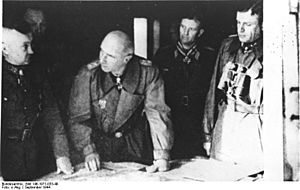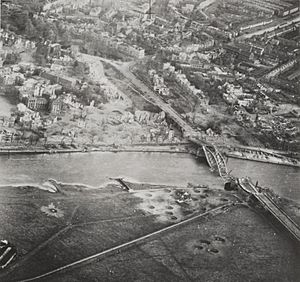Battle of the Nijmegen salient facts for kids
Quick facts for kids Battle of the Nijmegen salient |
|||||||
|---|---|---|---|---|---|---|---|
| Part of the Western Front of World War II | |||||||
 A British 17 pounder anti tank gun protects the road embankment on 'The Island', North of the Nijmegen road bridge |
|||||||
|
|||||||
| Belligerents | |||||||
| Commanders and leaders | |||||||
| Units involved | |||||||
|
|
||||||
The Battle of the Nijmegen salient was a series of fights in the Netherlands during World War II. It happened between September 30 and October 8, 1944. This battle took place right after Operation Market Garden, which was a big plan by the Allies that didn't quite work. Their goal was to quickly end the war by cutting off German forces.
After Market Garden, German commander Walter Model wanted to take back the area around Nijmegen. This area, called 'the Island', was important for the Allies. Wilhelm Bittrich led the German counter-attack, hoping to get back Nijmegen and its bridges. The German forces were not fully ready and often lacked tank support.
British forces, led by General Ivor Thomas, defended the area. Even though they lost some ground at first, the British stopped all German attacks. They then launched their own attack on October 4, taking back all the lost land and several villages. American troops from the 101st Airborne Division arrived to help. German attacks were defeated again. When the Arnhem road bridge was destroyed on October 7, the Germans stopped their major attacks. They had lost many soldiers and tanks.
| Top - 0-9 A B C D E F G H I J K L M N O P Q R S T U V W X Y Z |
Why the Battle Happened
After Operation Market Garden
In September 1944, the Allies started a huge attack called Operation Market Garden. They wanted to cross the Rhine river in the Netherlands. Their plan was to go around the strong German defenses called the Siegfried Line. This would help them push towards Berlin and trap German troops.
Allied paratroopers managed to capture some bridges. But delays and tough German resistance led to a defeat at the Rhine bridge in Arnhem. The Allied advance stopped south of the Lower Rhine. This created a narrow "salient" (a bulge in the battle line) that was easy for the Germans to attack. The area between the Rhine and Waal rivers became the new frontline. Soldiers called this area 'the Island'.
German Plans to Attack
The German commander, Walther Model, saw the Allied position near Nijmegen as a big threat. He worried the Allies could use it to cut off German armies and attack Germany itself. Even Adolf Hitler ordered the Allies in the Nijmegen-Arnhem area to be destroyed.
Model ordered Wilhelm Bittrich to attack the Allies between the Nederrijn and Waal rivers. Bittrich's plan was to use tanks and infantry to push the Allies out. He got two Panzer (tank) divisions, the 9th Panzer Division and 116th Panzer Division, for this attack. These divisions were moved from another important battle area.
Allied Goals
The Allies, led by Dwight Eisenhower, had problems getting supplies. Their supply lines were too long. They needed to clear the Scheldt river so that the huge port of Antwerp could be used. This would make it much easier to get supplies to the front lines.
By October 1, two important French ports, Boulogne and Calais, were captured. But they were badly damaged and couldn't be used right away. So, the Allies focused on opening Antwerp. They also needed to make the narrow "Market Garden" salient wider. This would help with the Scheldt operation and keep German forces busy.
Getting Ready for Battle
Attacks on Nijmegen Bridge
Before the main German attack, Model wanted to destroy Nijmegen's bridges. This would stop Allied supplies and troops. The British had strong anti-aircraft defenses there. German planes tried many times to bomb the bridges but lost many aircraft.
So, the Germans tried another way. On September 28, German frogmen (special divers) tried to blow up the bridges. They swam 10 km upstream to place explosives. The railway bridge was destroyed, but the road bridge was only slightly damaged. Out of twelve frogmen, three were killed and seven were captured. British engineers quickly repaired the damaged road bridge using a special Bailey bridge.
German Counter-Attack Begins
The German attack was delayed because of Allied bombing and a lack of fuel. The German tank divisions arrived without all their tanks. They had to use tanks that were already there.
On September 30, the attack began. Seventy tanks and many infantry (foot soldiers) attacked British positions. But the British easily pushed them back, causing heavy German losses. Another German attack across the Rhine was also stopped.
Fighting at Elst and Aam

The main German attack started on October 1. British forces, including the 7th Green Howards and 3rd Irish Guards, faced them. The Germans attacked with Tiger II tanks. Fighting was intense all day. The British defended Elst and Aam, stopping the German attacks.
Later that day, more German tank units attacked the British right side. But heavy British artillery fire and muddy ground stopped the tanks. The Germans lost several tanks, and one Tiger II was destroyed by a British PIAT anti-tank weapon.
All German attacks on October 1 were stopped. The Germans kept up the pressure through the night. In the early morning of October 2, they attacked the Irish Guards again. They used flame throwers and eight Panther tanks. One British 17-pounder gun was knocked out, but three German tanks were destroyed. The German attack failed again.
Allied Air Power
On October 2, General Thomas asked for air support. He wanted planes to attack German positions and disrupt their counter-attacks. When the sky cleared, RAF Hawker Typhoons attacked German tanks and soldiers. They also bombed German ferry sites and artillery positions. American bombers also targeted German troop areas, accidentally hitting some towns and causing civilian losses.
More German Attacks
Despite their failures, the German commanders kept pushing for more attacks. But their soldiers' morale was dropping. On October 2, some German soldiers deserted and told the British about another planned attack. They said their commander had refused to lead it.
New German attacks on October 2 and 3 tried to gain ground near Elst. But the British held their positions, causing heavy German losses. The 4th Somerset Light Infantry even launched a counter-attack, taking many prisoners.
Meanwhile, another German force tried to capture Driel. They attacked with Panther tanks. But the British 1st Dorsets held their ground. More attacks the next day also failed, with heavy German losses.
On October 5, American paratroopers from the 101st Airborne Division took over some British positions. They faced attacks from German tanks and infantry. One German assault gun was destroyed by a British 6-pounder gun. American patrols also found and defeated a large group of German infantry preparing to attack.
On October 6, the Germans launched a surprise attack on Opheusden and captured the village. A combined British and American counter-attack, supported by tanks, pushed the Germans out of parts of the village. House-to-house fighting was very fierce. The Americans ran low on ammunition and had to pull back. The battle for Opheusden became a stalemate. The village was heavily bombed by rockets and artillery, turning it into ruins.
End of the German Offensive
After a short break, the Allies decided to destroy the Arnhem road bridge. On October 7, American bombers hit the bridge directly. The bombs also set off German explosives on the bridge, causing it to collapse. This was a final blow to the German offensive. Without the bridge, they couldn't bring up heavy tanks and artillery.
Major fighting stopped on October 8. Sporadic attacks continued, but the Germans could not advance further.
After the Battle

The German counter-attack failed and they suffered heavy losses. Their tanks struggled in the muddy terrain. Without tank support, their infantry couldn't capture British positions. The Germans lost villages they had initially held. One German division, the 10th SS Panzer Division, had its worst day on October 4. Another, the 116th Panzer Division, lost around 800 soldiers. The Germans were also running out of experienced leaders.
British losses were moderate, but many infantry soldiers were killed or wounded. Most casualties were from heavy German artillery and mortar fire.
After the battle, the Allies focused on clearing the Scheldt river. This was important to open the port of Antwerp for supplies. Other operations were launched to expand the narrow "Market Garden" salient.
By mid-October, German forces began to pull out of the Arnhem bridgehead. They moved to other battlefronts. The British XII Corps took over the defense of the Nijmegen bridgehead. The 50th Northumbrian Division, which fought bravely, suffered nearly 900 casualties. This was their last major battle before returning to England.
The Allies later ordered people to leave 'the Island' because they expected the Germans to flood the area. It became known as "Men's Island" because only soldiers remained.
Later Fighting
Even after the main battle, there were more fights during the winter.
- On December 4, German paratroopers attacked British positions but were stopped. A leading company of 160 German soldiers was wiped out.
- On January 18, 1945, another large German attack happened near Zetten. After several days of fierce fighting, the Germans were surrounded. An entire German battalion (about 700 men) was destroyed or captured. This was the last German attack on 'the Island'.
'The Island' was fully captured in April 1945 during Operation Anger. British and Canadian forces pushed the Germans back over the Rhine. But for the civilians returning, the area was completely destroyed by the war.
Legacy
The American TV show Band of Brothers (episode five, 'Crossroads') shows the German attack on the Driel-Opheusden railway line on October 5 and 6.
Notable Participants
- Robert Boscawen - A British politician who was a First Lieutenant during the battle. He received the Military Cross for his bravery in helping to stop a German attack near Bemmel on October 3.




